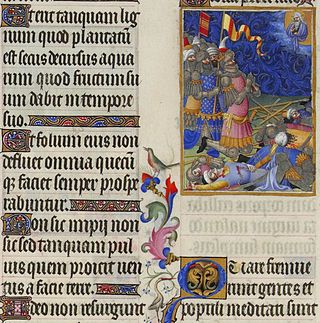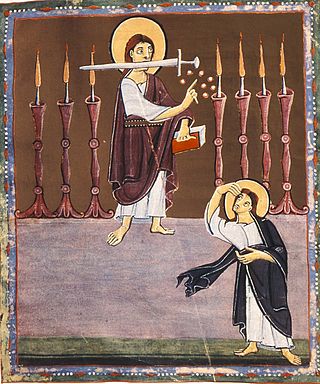
Judah ha-Nasi or Judah I, known simply as Rebbi or Rabbi, was a second-century rabbi and chief redactor and editor of the Mishnah. He lived from approximately 135 to 217 CE. He was a key leader of the Jewish community in Roman-occupied Judea after the Bar Kokhba revolt.

Simon bar Kokhba or Simon bar Koseba, commonly referred to simply as Bar Kokhba, was a Jewish military leader in Judea. He lent his name to the Bar Kokhba revolt, which he initiated against the Roman Empire in 132 CE. Though they were ultimately unsuccessful, Bar Kokhba and his rebels did manage to establish and maintain a Jewish state for about three years after beginning the rebellion. Bar Kokhba served as the state's leader, crowning himself as nasi. Some of the rabbinic scholars in his time imagined him to be the long-expected Messiah of Judaism. In 135, Bar Kokhba was killed by Roman troops in the fortified town of Betar. The Judean rebels who remained after his death were all killed or enslaved within the next year, and their defeat was followed by a harsh crackdown on the Judean populace by the Roman emperor Hadrian.
"Son of man", "son of Adam", or "asa man", are phrases used in the Hebrew Bible, various apocalyptic works of the intertestamental period, and in the Greek New Testament. In the indefinite form used in the Hebrew Bible, it is a form of address, or it contrasts humans with God and the angels, or contrasts foreign nations, which are often represented as animals in apocalyptic writings, with Israel which is represented as human, or it signifies an eschatological human figure.

Saʿadia ben Yosef Gaon was a prominent rabbi, gaon, Jewish philosopher, and exegete who was active in the Abbasid Caliphate.

Shimon bar Yochai or Shimon ben Yochai, also known by the acronym Rashbi, was a 2nd-century tanna or sage of the period of Roman Judaea and early Syria Palaestina. He was one of the most eminent disciples of Rabbi Akiva. The Zohar, a 13th-century foundational work of Kabbalah, is ascribed to him by Kabbalistic tradition, but this claim is universally rejected by modern scholars.
A Hebrew name is a name of Hebrew origin. In a more narrow meaning, it is a name used by Jews only in a religious context and different from an individual's secular name for everyday use.
Biblical Aramaic is the form of Aramaic that is used in the books of Daniel and Ezra in the Hebrew Bible. It should not be confused with the Targums – Aramaic paraphrases, explanations and expansions of the Hebrew scriptures.
Sherira bar Hanina more commonly known as Sherira Gaon was the gaon of the Academy of Pumbeditha. He was one of the most prominent Geonim of his period, and the father of Hai Gaon, who succeeded him as Gaon. He wrote the Iggeret Rav Sherira Gaon, a comprehensive history of the composition of the Talmud.
Ḥiyya bar Abba, Ḥiyya bar Ba, or Ḥiyya bar Wa was a third-generation amoraic sage of the Land of Israel, of priestly descent, who flourished at the end of the third century.

Helpetha I, commonly mispronounced Halafta, was a rabbi who lived in Sepphoris in the Galilee during the late 1st and early 2nd centuries CE. He was the father of Jose ben Helpetha and Shimon ben Helpetha, also serving as their teacher. He is cited without patronymic or cognomen in the Mishnah, but as Abba Helpetha in the Talmuds.
Hanina ben Dosa was a first-century Jewish scholar and miracle-worker and the pupil of Yohanan ben Zakkai. He is buried in the town of Arraba in the Lower Galilee.
In Jewish eschatology Mashiach ben Yoseph or Messiah ben Joseph, also known as Mashiach bar/ben Ephraim, is a Jewish messiah from the tribe of Ephraim and a descendant of Joseph. The figure's origins are much debated. Some regard it as a rabbinic invention, but others defend the view that its origins are in the Torah.
Hanina bar Hama was a Jewish Talmudist, halakhist and aggadist frequently quoted in the Babylonian and the Jerusalem Talmud, and in the Midrashim.
Samuel ben Nahman or Samuel [bar] Nahmani was a rabbi of the Talmud, known as an amora, who lived in the Land of Israel from the beginning of the 3rd century until the beginning of the 4th century.
Natronai ben Nehemiah was Gaon of Pumbedita from 719 to 730; son-in-law of the exilarch Ḥasdai I. Vain of his family connections and secure in his position, he was so arrogant in his dealings with the students that many of them left the academy, returning only after his death.

Psalm 2 is the second psalm of the Book of Psalms, beginning in English in the King James Version: "Why do the heathen rage". In Latin, it is known as "Quare fremuerunt gentes". Psalm 2 does not identify its author with a superscription, but Acts 4:24–26 in the New Testament attributes it to David. According to the Talmud, Psalm 2 is a continuation of Psalm 1.

Sura Academy was a Jewish yeshiva located in Sura in what is now southern Iraq, a region known in Jewish texts as "Babylonia". With Pumbedita Academy, it was one of the two major Jewish academies from the year 225 CE at the beginning of the era of the Amora sages until 1033 CE at the end of the era of the Gaonim. Sura Academy was founded by the Amora Abba Arikha ("Rav"), a disciple of Judah ha-Nasi. Among the well-known sages that headed the yeshiva were Rav Huna, Rav Chisda, Rav Ashi, Yehudai ben Nahman, Natronai ben Hilai, Saadia Gaon, and others.

Son of man is an expression in the sayings of Jesus in Christian writings, including the Gospels, the Acts of the Apostles and the Book of Revelation. The meaning of the expression is controversial. Interpretation of the use of "the Son of man" in the New Testament has remained challenging and after 150 years of debate no consensus on the issue has emerged among scholars.
Ben adam in biblical Hebrew it simply means human being. For example, "son of man" in Job chapter 25 and Psalm 146 is ben adam, illustrating the Jewish concept of "son of man".
Kiryat Arbaya is an ancient settlement mentioned in two letters written by Simon Bar Kokhba, discovered in the Cave of Letters in Nahal Hever. The settlement has been proposed to be identified with the Arab village of Al-Arroub south of Gush Etzion or with Khirbet Arbaya nearby, close to the road between Bethlehem and Hebron. This area is located between Ein Gedi and Betar, where Bar Kokhba's main camp was likely situated. The literal meaning of the name is 'City of the Arabs' or – what might be more plausible in light of the letter's content – 'City of the Willows'. Additionally, some have suggested identifying Kiryat Arbaya from Bar Kokhba's letters with the legend of the birth of the Messiah that appears in the Jerusalem Talmud and in Lamentations Rabbah.